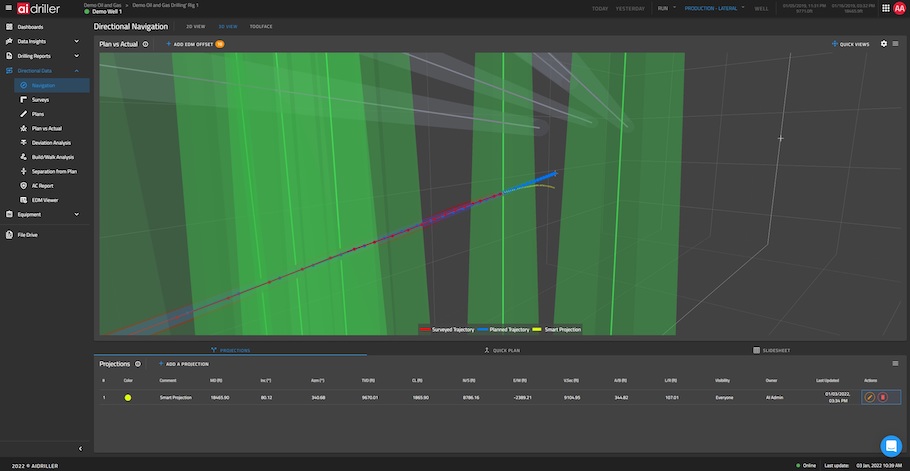Presented by:

This article appears in the E&P newsletter. Subscribe to the E&P newsletter here.
The oil and gas industry is on a continued journey of efficiency gains through digitization and remote operations. This offers companies the best chance to scale safely, quickly, and successfully. However, to realize greater operational efficiencies, E&P and directional drilling companies must implement intelligent digital solutions to enable greater collaboration across the team. Unfortunately, for many companies even today, implementing the right tool into the existing process can be a challenge and can often cause time and money down the drain.
Here is the AI Driller’s four-step protocol with case study for successful remote operations and drilling optimization.
1. Set the clearly understood goals
Digital solutions are often designed to perform very specific functions and it’s fairly common to prescribe the wrong tool for a use case that it’s not really intended for. This can quickly lead to frustration of the team, especially if the tool doesn’t actually perform for the use case you purchased it for.
Case in point: One of our customers, a major US-based E&P company, wanted to implement integrated drilling optimization and remote operations platform to:
- Improve drilling consistency and delivery time in intermediate and production sections
- Prevent well collision events while maintaining high drilling speeds
- Quickly identify and share best practices and KPIs across the entire organization
2. Define and understand your ideal drilling process
It is often, there are just “too many things going on” to allow drilling teams the time to figure out a new drilling solution and integrate that into their existing processes. A thorough understanding of your ideal drilling process should lead you to the necessary tools – not the other way around.
It is crucial to step back and ask yourself:
- Is our current drilling process working as efficiently as it could? Is this the best use of resources and time to get to the desired outcome?
- Can we automate parts of this process? Is it a scalable process?
- Leaving technology aside, what would be the absolutely optimized way to execute this process?
Case in point: After this exercise, we have identified with the Customer:
- Ideally, directional driller should focus mainly on optimizing drilling parameters to guarantee performance and consistency
- Daily reporting has to be automated to allow them to focus on drilling performance instead of grunt work
- Survey, Projection management and Anti-Collision monitoring need to be automated and visible at the rig and in the office
- Ideally, drilling engineers and management can easily track drilling KPIs per crew, well, rig, pad and share best practices with the field team
3. Assemble the toolkit for Remote Operations
At every step of the new process, ask: What functionality is required here to achieve the optimal execution of this step? This will allow you to know exactly what tools you need for remote operations and on which features to evaluate your options.
Case in point: Customer needed an integrated platform for real-time drilling operations with the following tools:
- Automated daily drilling reports and slide sheets
- Reliable directional navigation with automated surveys and projections
- Robust Anti-Collision module integrated with Landmark EDM
- Real-Time logs with Offsets and AI-based recommendations
- Business Intelligence tools to track drilling KPIs and set monthly/quarterly objectives for the team
- Equipment management to track vendor performance and identify the best motor/bit combinations for the area

4. Execute, accelerate, and scale your remote operations
With your ideal processes in place, you increase the likelihood of identifying, quickly integrating and implementing the perfect digital tools for your remote operations. But don’t try to digitize until you’ve worked on the other 3 steps first. At this step, it is also important to set challenging, ambitious goals with measurable results.
Case in point: Customer has successfully integrated AI Driller Cloud into their new ideal process and scaled up the system across the entire team:
- Integrated Well Intelligence and Business Intelligence platforms to keep drilling teams, tools, data, and KPIs centralized while
- Uploaded 2 years of historical drilling data within a few weeks to kick start the process and set benchmarks
- Identified key inefficiencies and areas for improvement leading up to $5M of savings per rig per year
- Set aggressive drilling goals throughout different company levels and implemented tools to share, track progress, create alignment, and encourage engagement of the entire team around key metrics
- Implemented Anti-Collision monitoring and automated 99% of manual reporting for directional drillers allowing them to focus on drilling optimization and achieve new goals
- Replaced multiple existing software packages with a unified solution to reduce additional spending and data silos
- Successfully onboarded field crews and operations team on the new tools as well as identified additional features to be implemented for further drilling improvements and optimizing the process
The digital tool itself doesn’t really matter. Features, integrations, configuration – none of that matters beyond the tool’s ability to be the right tool for the job. Hopefully, this article will help you get the right tools in place and scale up your remote operations safely, quickly, and successfully. Happy and productive drilling!
